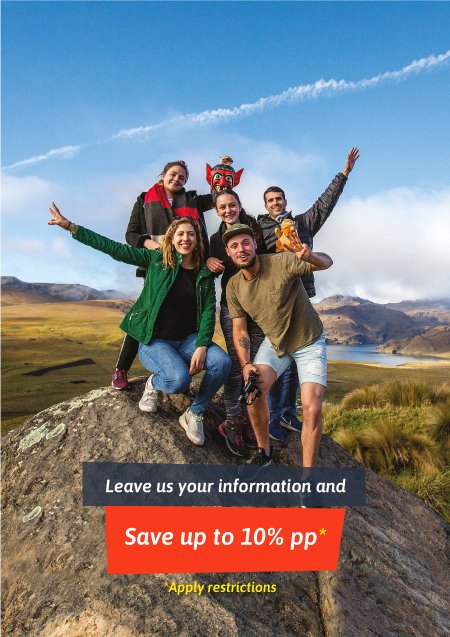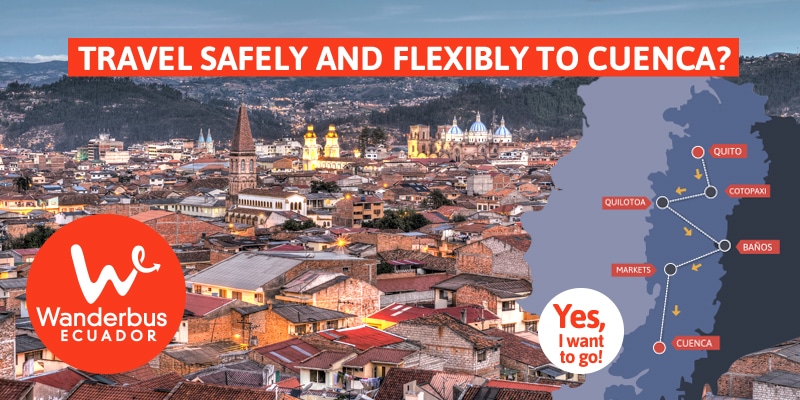Wander Cuenca
A lovely place to discover
Why visit Cuenca
Known for its picturesque historic city center, Cuenca has become a destination for foreign retirees and is a lovely place to stop through while traveling around Ecuador. Like Quito, Cuenca is a high-altitude metropolis and sits at 2,550 m (8,370 ft) along the Ecuadorian Andes.
Cuenca is an ideal stop after days on the beach or jungle, where you might have sacrificed some daily discomforts. A modern city, it has become the home to a relatively new international community made up of retirees and travelers that aren’t in any hurry to leave. To cater to this new demographic, small cafes and restaurants have popped up around the city and significant improvements have been made to infrastructure and services. Cuenca is simply a lovely place to spend a few days, combined with a trip to the nearby Parque Nacional de Cajas.
How to get to Cuenca
As one of Ecuador’s major cities, you’ll find numerous modes of transport to get you there.
Public transportation: If you’re traveling by bus, you’ll need to leave from Quitumbe (“Terminal terrestre Quitumbe”) to get from Quito to Cuenca. If you’re staying in Quito’s historic center or Mariscal district, Quitumbe is a $10-20 taxi ride (depending on the time of day) or a $0.25 trip on the Trole. However, try to avoid taking the Trole by night and always keep an eye on your possessions when you’re using public transport in and around Quito.
Once in Quitumbe, you’ll find a number of bus companies that depart to Cuenca. The trip from Quito to Cuenca takes about 10 hours and costs around $10. Since it may be a long ride, select a bus company that appears to have comfortable seats!
Wanderbus Ecuador: For a trip as long as the Quito to Cuenca route, an excellent alternative to public transportation is the Wanderbus.
A number of our Wanderbus passes take you from Quito to Cuenca, stopping at a few must-see destinations like Cotopaxi, Quilotoa, Baños and Riobamba. If your travel plans aren’t set in stone, you should seriously consider this option. This way, the 10-hour journey to Cuenca will be broken up into more manageable chunks, giving you the chance to see the best of the Ecuadorian Andes and completely skip the inconvenience and discomfort of traveling on regular buses.
Essential Info
History
Most people aren’t aware that Cuenca is officially called, “Santa Ana de los Cuatro Ríos de Cuenca”. Located at around 2,560 meters (8,400 feet) above sea level, it is listed as a UNESCO World Heritage Site due to the numerous historical buildings located in its city center.
Indigenous ethnic groups inhabited the area of Cuenca long before Spanish colonizers arrived to “found” the city. Among these are the Cañari, which were later conquered by the Incans. At this point, Cuenca was called “Tomebamba” and became a second Cusco. In 1557 Spanish colonizers renamed the city after a town in Spain.
Health and Safety
Before traveling to Ecuador, it is strongly recommended you purchase travel insurance in case of any emergency, including health and loss of possessions.
In the case of an emergency, you can reach an ambulance by dialing 911 or 102 (Quito Fire Department), 131 (Red Cross) or 101 (Police).
Hospitals in Cuenca
Due to the large, and senior, international population in Cuenca, there are a number of hospitals and clinics available, many with English-speaking staff. Among these include:
Clínica Paucarbamba
Av. Paucarbamba 4138 y Santiago Carrasco, tel.: +59372-818-111
Clínica Santa Ana
Av. Manuel J Calle 1- 104 y Paucarbamba, tel.: +59372-817-564
Hospital Latinoamericano
Av. 3 de Noviembre y Unidad Nacional, tel.: +59372-839-704
Hospital Monte Sinai
Miguel Cordero 6-111 y Av. Solano tel.: +59372-885-595
Clínica Santa Inés
Daniel Cordova 2-67 y Agustin Cueva tel.: +59372-827-888
Hospital del Rio
Av. 24 de Mayo y Av. De las Américas, tel.: +59372-459-555
Pharmacies in Cuenca
Numerous pharmacies can be found in and around Cuenca. The bigger chains include Fybeca, Sana Sana and Cruz Azul. This link will indicate the pharmacies registered on Google Maps.
ATMs in Cuenca
ATMs can be found almost anywhere around town, with a higher density in the city center. We always recommend using the larger banks like Banco del Pichincha, Banco del Pacifico or Banco de Guayaquil, to reduce the risk of your card not being read. Here is a link to ATMs in Cuenca on Google Maps.
Always try to plan ahead so that you don’t need to visit the ATM very often, increasing chances of being targeted by thieves, and always avoid taking cash out in the evening.
Wifi in Cuenca
Wifi can be accessed in almost any restaurant in cafe you come across. A few comfortable places to visit for wifi are: El Cafecito, Cafe Nucallacta and San Sebas.
Popular Activities do do in Cuenca
Due to its location and history, there are plenty of things to do in Cuenca. Numerous museums and buildings around its historic center preserve elements of the city’s rich history, made accessible to all visitors.
As a city along the Andes mountain range, it also offers access to the impressive vistas and natural environments in its surroundings.
And, finally, as an increasingly popular destination among foreign nationals, the demand for live music and quaint cafes has also increased, making it a comfortable, and fun, destination for travellers of all demographics.
Stop at a cafe, read a book, and people watch
If you took the 10-hour bus ride down from Quito, the museums can wait; you deserve some R&R. Cuenca’s Parque Calderón, as well as other plazas speckling the city, are the perfect spots to sit and people watch. And if you prefer to people watch while sipping some locally produced coffee, you can do that at one of our favorite Cuencan cafes: El Cafecito, Cafe Nucallacta or San Sebas
Cuenca’s Museum Route
The “Ruta de los Museos”, or Museum Route, is an activity promoted by Cuenca’s Municipal Department of Culture and is a wonderful way to delve into local culture and history. Along the route, make sure to stop by the Pumapungo ruins and the Remigio Crespo Toral Museum, two stops you really can’t miss.
While you can undertake the route yourself, most of the museums offer guided tours as well. The best part? It’s practically free! Most of the museums along the route have free admission, though a handful charge a minimal fee, from $0.50-$4.00 per person.
Keep in mind that many museums and convents close for the weekend on Saturday morning.
Buy souvenirs at the Plaza San Francisco Market
The San Francisco Market is a hub of activity and sells everything from plasticware to Otavaleño alpaca sweaters. Local Ecuadorians shop here for their basic supplies, giving the market an authentic feel, compared to other markets that are mainly geared to attract tourists.
While you’re there, grab a bite to eat at one of the food stalls and stop by the souvenir stalls along the north side. Another fun market to visit is the Mercado 10 de Agosto, full of fruit and vegetables. You can even experience an Andean “limpia” cleansing ceremony there.
A double decker bus tour leaves from Parque Calderon on an hourly basis throughout the week and will help give you a sense of the city, and also provides interesting facts about Cuenca’s history and culture (English and Spanish). The bus operates from 10:00 am – 7:00 pm on weekdays and Saturdays and on Sunday operates from 10:00 am – 5:00 pm.
The tour lasts around 2 hours, so make sure to bring some snacks, and tickets cost $8 per person for either the north or south route. If you choose to do both, that costs you $12.
Listen to live music
A relaxing activity to do in any city, and a great way to befriend fellow music lovers, is to visit a few local venues that offer live music.
If you like classical music, performances at the Cuenca Symphony Orchestra are free to the public. The Cuenca Jazz Society Cafe and Santa Canela Hostal Bar & Grill regularly offer live jazz and blues in a cozy environment, and the Broken Bridge Tavern is also known to bring musicians in for entertainment.
Stroll along the river
A lovely morning activity is to stroll along Rio Tomebamba, one of the rivers that divides Cuenca’s historic center from the more modern southern side of the city. A (mostly) paved path runs along the river and if you prefer to cycle, you can rent a bike at TerraDiversa. Look out for the Parque de la Mujer on the south side of the river, which was regenerated not long ago.
If you don’t have much time, you’ll find the nicest section of the walk along Calle Larga toward the University of Cuenca.
CIDAP (Inter-American Center of Popular Arts) museum and shop
Though not part of the aforementioned Museum Tour, the CIDAP museum is well worth a visit due to its location and its curated exhibits. The museum is dedicated to spotlightling the work of artisans and popular crafts in South America, such as textiles, woodwork, ceramics and more.
Admission to CIDAP is free and the museum is open everyday except for Sunday from 10:00 am to 5:00 pm. While you’re there, check out their store, El Barranco, where you can purchase many fair-trade products from across Ecuador, including some woven hats, shoes, leather-ware, jewelry, etc. They also have a very good café, serving great coffee and Belgian waffles.
Top tip
The Remigio Crespo Toral Museum is worth a visit if only for its fabulous riverside café, a blissful place to sip sangria and watch the world go by in the shade of ancient trees. But check in advance opening hours of any museum you visit – they have a habit here in Cuenca of opening and closing at peculiar times.
Planning Your Time in Cuenca
Planning your time in Cuenca depends entirely on what YOU like doing, but we’ve listed some of the highlights. We encourage you to take these and customize your itinerary based on the amount of time you have, personal preferences and your budget.
Where to Stay in Cuenca
There are many accommodation options to choose from in Cuenca. We recommend finding a place in and around the scenic historic center or by the river, but this might depend on your budget. Apart from a number of great Airbnb options, these are some of our favorite hostels in Cuenca:
Santa Canela Hostel & Restaurant – Located near the Termas del Daymán, this is a quiet and comfortable spot with a garden, swimming pool and daily breakfasts.
Casa Montalvo Bed & Breakfast – Casa Montalvo is built in a beautiful old house that gives guests a sense of Cuencan culture and history through its architecture and decor. Its highlights include the daily breakfast menu and the rooftop terrace where guests can hangout.
Hotel Boutique Los Balcones – Staying here might be a splurge, but is well worth it! The hotel offers guests high quality accommodation, comfortable beds, and is well located in the city.
Cuenca rooms B&B – This is a small but cozy option and is located only a few blocks from the historic center, giving you easy access to many of the attractions, cafes and activities Cuenca has to offer.
Apartamentos Otorongo: A budget-friendly option, Otorongo is a cozy spot situated in a quiet part of the city, yet still close to the heart of town. The owners are a great resource for adventure travelers that want to get on trails or mountain bike. This is also a good option for extended stays as they rent out entire apartments.
Where to Eat in Cuenca
Splurge
Los Tiestos: One of the top rated restaurants in Cuenca. Clients rave about the shrimp soup and there are also vegan and vegetarian options available. Make sure to reserve in advance.
El Mercado: A friendly (and fully bilingual) spot with a fresh, local menu and a great selection of wine. While it’s best known for its seafood, it offers a wide variety of dishes.
Hotel Santa Lucía: A high-value, elegant restaurant (and hotel) built from a restored house. It also offers vegetarian and vegan options.
Mid-price
Pizzería Marea: Pizzeria Marea uses an adobe, wood-fired oven to make its pizzas in Cuenca and in Montañita. Other food options are available, such as pasta, and in Cuenca you can also get breakfast here.
San Sebas: Another cozy spot with great breakfasts, lunch and coffee in Cuenca. They also organize fun events like “Vino & Van Gogh”.
Remigio Crespo Toral Museum and Restaurant: Once the home of the Cuencan poet, diplomat and academic, Remigio Crespo Toral, this incredible building is now open to the public, following a process of restoration. Entry to the museum is free and on the bottom floor you’ll find a lovely restaurant overlooking the river.
Other local spots
Salón Tres Estrellas: If you’re looking for a local spot with some good options, try Salón TRes Estrellas, located on Calle Larga. One of their delicacies is cuy (guinea pig). In fact, this is probably the best spot in town to taste this Ecuadorian dish.
Guajibamba: A lovely restaurant to taste other local dishes and drinks, like the delicious canelazo.
When to Visit Cuenca
There’s really no wrong time to visit this lovely city. The climate here is similar to that of Quito 15-22 C (60-70 F) and is often describes a perennial spring. However, during rainy season and because of its elevation, Cuenca gets quite cold. Since buildings here aren’t made to withstand cold weather, it can feel quite chilly indoors as well.
With that in mind, try to visit Cuenca during its dry season, which is between June and December. Regardless, always bring a light sweater and rain protection with you since the weather in the Andes can shift quite suddenly.
Beyond Cuenca — Sites to Visit Nearby
Explore Cajas National Park
If you love hiking and nature, you can’t skip a visit to Cajas National Park. In fact, one of the main reasons people come to Cuenca is to visit this otherworldly place.
Only 30 km away from Cuenca, Cajas National Park covers a vast 285.44 km2 (28,544 ha) and ranges between 3100m and 4450m in elevation.
The high grassland ecosystem here, also known as the paramo, combined with the mountain fog and placid lagoons makes Cajas an incredible place to explore. As you hike through the park, keep your eyes open for the South American condor, one of only eighty left in the country.
Visit the Ingapirca Ruins
The Ingapirca Ruins are the largest known Inca ruins in Ecuador and you can visit them from Cuenca on an easy day trip. The name Ingapirca means “wall of the inca” and this site is believed to have been of religious importance where sacred rituals once took place.
The ruins are open everyday from 9:00 am to 5:30 pm and admission costs $2.00. You can get to the ruins by bus from Cuenca’s bus terminal or you can go with a tour operator. Once there, take a guided tour to understand the backstory and symbology of the various structures.
Cuenca Packing List
Your packing list may vary depending on the activities you decide to do and on the weather.
Apart from your regular packing items, you should include the following to your packing list:
- Comfortable shoes to walk, hike, climb
- Sandals to change into back at the hotel
- Rainproof jacket
- Change of clothes for wet day trips
- Sun protection (hat, sunglasses, sunblock)
- Layers and warmer gear (fleece, windbreaker), especially if going to Cajas.
Optional: GoPro or other waterproof camera to capture your adventures!
What Next?
In Cuenca, you’re at the southernmost end of the Ecuadorian Andes. Depending on which direction you’re coming from, you might want to continue on to the coast, towards Montañita and Puerto Lopez or, if you’re heading in the opposite direction, jump on the Wanderbus up through the Andes, Ozogoche, to Baños and the deeper Amazon.



